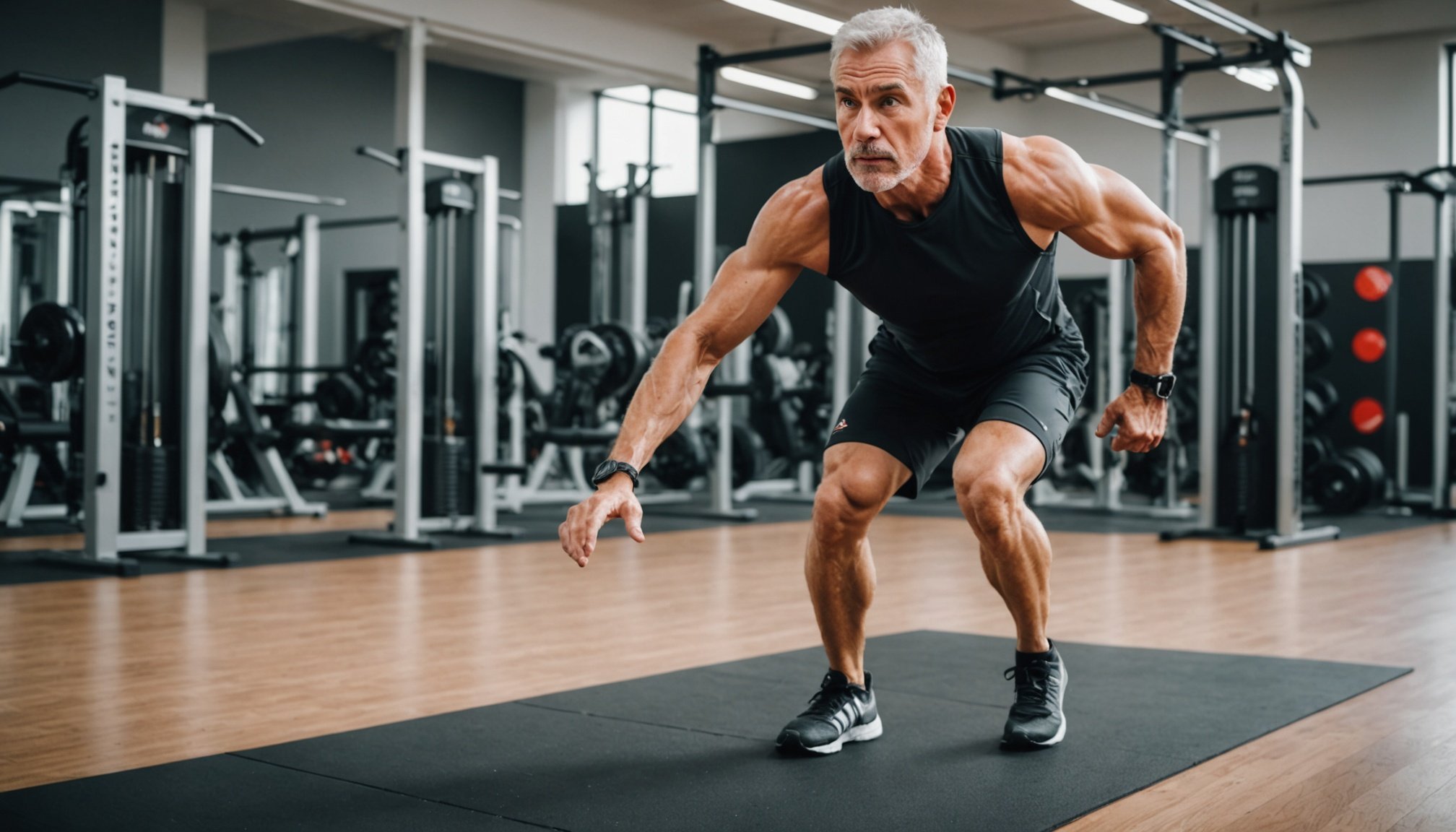Introduction to High-Intensity Training and Cardiovascular Health
High-Intensity Training (HIT) has grown in popularity due to its effectiveness and efficiency. This form of exercise involves short bursts of intense activity followed by rest or low-intensity periods. The primary principle is to push individuals to maximal effort during each intense burst, aiming to improve cardiovascular health rapidly. Crucially, it optimises the heart’s ability to pump blood and enhances the body’s oxygen utilisation.
For middle-aged athletes, maintaining cardiovascular health becomes increasingly important. As the body ages, the risk of heart diseases rises, making heart health a priority in fitness routines. HIT can serve as a potent remedy by elevating heart rate swiftly, which may encourage heart health improvements in a time-efficient manner. Engaging in HIT can help middle-aged athletes maintain stamina and endurance while also warding off cardiovascular diseases.
In parallel : The Impact of Hydration on Mental Performance in Long-Distance Running: Unveiling the Connection
In today’s fitness landscape, the relevance of this topic cannot be overstated. The shift towards more dynamic, result-driven workout regimes underscores the need for approaches like HIT. It empowers individuals to achieve fitness goals and maintain heart health without spending extensive hours in the gym. By integrating HIT into routines, athletes can enhance their training effectiveness significantly.
Scientific Studies on High-Intensity Training and Cardiovascular Benefits
Scientific studies have extensively examined the cardiovascular benefits of high-intensity training (HIIT). Research consistently indicates that HIIT significantly enhances cardiovascular health by improving heart function, increasing blood flow, and boosting overall vessel health. Compared to traditional moderate exercise, HIIT often results in more pronounced improvements in a shorter time frame.
This might interest you : Find local pick up soccer games in new york city today
Research suggests that HIIT’s effectiveness is rooted in its capacity to push the heart to higher levels of exertion, thereby promoting more efficient oxygen use and improved cardiac efficiency. These intense bursts of exercise followed by recovery periods stimulate adaptations in the cardiovascular system more efficiently than sustained moderate exercise.
Furthermore, long-term cardiovascular outcomes for participants engaging in high-intensity training are promising. Studies show a substantial reduction in risk factors associated with heart disease, such as high blood pressure and elevated cholesterol levels. The “Heart Health Project” found that HIIT participants experienced an 18% reduction in blood pressure over six months compared to a 12% reduction for those engaging in moderate exercise.
This adaptive response underscores the significant cardiovascular benefits associated with regular HIIT, positioning it as a preferred choice for those seeking robust heart health improvements within a compressed timeline.
Health Benefits of High-Intensity Training for Middle-Aged Athletes
High-intensity interval training (HIIT) offers significant health benefits for middle-aged athletes. One of the primary advantages is the enhancement of aerobic capacity, which plays a crucial role in boosting endurance. This improvement allows athletes to perform longer and more strenuous activities without experiencing fatigue as rapidly.
Moreover, HIIT contributes to reducing cardiovascular disease risk factors. How does HIIT achieve this? By promoting heart health and improving circulation, HIIT aids in decreasing unhealthy cholesterol levels and lowering blood pressure, thereby reducing the likelihood of developing heart diseases. Regular engagement in HIIT can thus be a proactive step towards maintaining a healthy heart.
Another critical benefit of high-intensity training is its impact on metabolic health. HIIT helps in regulating blood sugar levels, thereby lowering the risk of type 2 diabetes. It also aids in efficient weight management, by accelerating fat loss and increasing lean muscle mass. This is particularly beneficial for middle-aged athletes who often experience metabolic slowdowns.
For middle-aged athletes, integrating HIIT into their regimen can prove to be an effective strategy for maintaining overall health and peak performance.
Risks and Considerations for High-Intensity Training
Engaging in high-intensity training offers substantial benefits, but for middle-aged athletes, it comes with specific risks. One primary concern is an increased risk of injury, especially for individuals who may not have been consistently active. Older adults often face issues like decreased bone density and joint flexibility, making them more susceptible to sprains and strains.
Safety precautions are critical in minimizing these risks. Before starting any new regimen, it is essential that middle-aged athletes assess their readiness for high-intensity workouts. This involves a self-evaluation of physical fitness levels, as well as consulting with professionals such as personal trainers who can tailor the training plan to suit individual needs and capacities.
Obtaining medical clearance is another critical step. Middle-aged individuals should seek clearance from healthcare providers to confirm that their bodies can handle the increased demand of such workouts. Supervision during training is equally important. Having an experienced trainer or coach ensures exercises are performed correctly, further reducing the risk of injury.
By taking these precautions, middle-aged athletes can enjoy the benefits of high-intensity training while minimizing potential risks. Understanding your body’s limitations and working within those bounds is essential for a safe and effective workout regime.
Practical Training Advice for Middle-Aged Athletes
Engaging in high-intensity interval training (HIIT Protocols) can be rewarding for middle-aged athletes. Structured correctly, these Exercise Regimens enhance physical fitness and well-being.
Structuring Effective HIIT Workouts
To ensure safety and efficiency, it’s crucial to tailor HIIT sessions. Begin with a proper warm-up to raise your heart rate gradually, preparing your body for more intensive exercises. Incorporate a mix of aerobic and anaerobic exercises, targeting different muscle groups. Consider movements like sprints, jumping jacks, and squats. This variation maintains interest and encourages comprehensive muscle engagement. Limit high-impact exercises if joint pain is present, replacing them with low-impact options like brisk walking or cycling.
Frequency and Duration Recommendations
For middle-aged individuals, Training Advice suggests engaging in HIIT workouts 2-3 times a week. Duration should vary between 20 to 30 minutes per session, including a warm-up and cool-down. This approach minimizes the risk of injury while maximizing cardiovascular and strength benefits.
Integrating Recovery and Rest Days
Rest days are pivotal in a HIIT regimen, aiding in muscle recovery, preventing burnout, and reducing injury risk. Integrate active recovery exercises like yoga or swimming to maintain activity without excessive strain. Listening to your body’s signals is essential; proper recovery enhances performance and sustainable progress.
Personal Anecdotes from Middle-Aged Athletes
Delve into the world of real-life impacts through personal experiences of middle-aged athletes who have embraced high-intensity interval training (HIIT). This method has reshaped their athletic performance, propelling them to new levels of fitness while also presenting unique challenges.
In their HIIT testimonials, athletes reveal a dual narrative: the invigorating thrill of improved stamina and the daunting hurdle of recovery time. Athletes often note a significant boost in endurance and strength, which becomes evident through quicker sprints or heavier lifts. Yet, it’s not all smooth sailing. The intense nature of HIIT sometimes necessitates longer recovery periods, especially for those not accustomed to such rigorous activity.
These athlete stories also shed light on community feedback. Many found transitioning to a HIIT regimen camaraderie-inspiring, as communities offered moral support and motivation. Despite the intensity, a shared spirit of resilience and determination binds these athletes together, driving continual improvement and mutual encouragement.
Challenges aside, the stories collectively underscore a transformative journey—a testament to the profound effect that high-intensity training can have on personal growth and communal bonding.
Expert Opinions and Interviews
To better understand the role of HIIT for middle-aged athletes, engaging insights from fitness professionals provide crucial direction. Many experts agree that HIIT offers significant benefits, such as improved cardiovascular health and increased muscle strength. However, customizing plans to accommodate varying fitness levels is essential.
Fitness trainers emphasize the importance of gradually introducing HIIT to medium-paced workouts, ensuring a smoother transition for those who might not be accustomed to intense regimens. By progressively increasing workout intensity, individuals can prevent injury risk and maintain enthusiasm.
Cardiologists recommend focusing on safe practices within the HIIT framework. They highlight monitoring heart rates to avoid over-exertion. For middle-aged athletes, incorporating longer recovery phases can enhance safety.
Expert perspectives are often built upon real-life scenarios from clients, affirming the adaptability of HIIT with proper guidance. Experienced trainers employ meticulous assessments to tailor programs to individual needs, aligning with health objectives while minimizing the risk of injury. The balance of intensity and rest in personalized intervals is key.
Fitness professionals comprehend that customizing plans caters to each individual’s condition, ensuring sustainable benefits from HIIT for both health and performance.
Comparative Analysis: High-Intensity Training vs. Moderate Exercise
In evaluating cardiovascular health outcomes, both High-Intensity Interval Training (HIIT) and moderate exercise reveal distinct benefits. HIIT typically enhances cardiovascular performance by combining short bursts of intense exertion with brief recovery periods, leading to significant improvements in heart health over time. This structured variation elevates heart rate more effectively than steady moderate exercise.
Moderate exercise, such as brisk walking or cycling, offers cardiovascular benefits as well, albeit at a fluctuating pace. It is more commonly associated with sustained heart health, particularly beneficial for individuals easing into a fitness routine. Its lower intensity reduces the risk of injury, making it more suitable for beginners or those with certain health conditions.
When comparing HIIT vs Moderate Exercise based on suitability for different fitness levels, novice athletes may find moderate activities less demanding, thus more approachable. Conversely, HIIT offers a dynamic and challenging option for seasoned athletes seeking rapid changes in physical performance.
Empirical evidence indicates that while HIIT can significantly improve aerobic capacity, moderate exercise consistently enhances endurance. The variability in athlete experiences suggests the importance of tailoring fitness programs to individual needs, considering personal goals, current health status, and lifestyle preferences.
Recommendations for Safe Practice
Engaging in high-intensity interval training (HIIT) provides numerous benefits. However, adhering to certain HIIT guidelines ensures a safe and effective workout. To start, consider the following recommended practices:
- Warm-Up: Begin with a comprehensive warm-up to prepare your muscles and joints, reducing injury risk.
- Technique Focus: Maintain proper form during exercises to maximise effectiveness and minimise strain.
- Listen to Your Body: Pay attention to physical limits; adjust the intensity if discomfort or pain occurs. This ensures sustainability and protection against overexertion.
- Proper Equipment: Use appropriate footwear and clothing to enhance performance and safety.
- Hydration: Keep hydrated throughout your workout to maintain energy levels and physiological balance.
Ongoing Monitoring
Monitoring individual progress is crucial. Regularly assess performance metrics like heart rate and endurance. Adjust your training regime based on personal health status, ensuring it aligns with fitness recommendations. If necessary, consult a fitness professional to tailor a program suited to specific needs. By following these safe practices, individuals can enjoy the benefits of HIIT while minimising potential risks.











